The Women's Social and Political Union was a United Kingdom organization whose members were passionate in the pursuit of winning for women the vote. They were known as suffragettes and were also known for their political activism and civil disobedience.
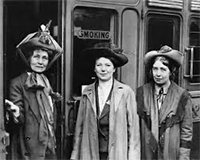
Among the founders of the organization known as the WSPU, which formed originally out of the National Union of Women's Suffrage Societies, were three members of the Pankhurst family–Emmeline, Christabel, Sylvia. Emmeline's husband, Richard, had been a strident supporter of social issues, including an expansion of rights for women. He and Keir Hardie had been active in the Independent Labour Party, and Hardie later founded the Labour Party. Emmeline founded the WSPU with a meeting on Oct. 10, 1903 at her house in Manchester. Her daughters, Christabel and Sylvia, were also founding members.
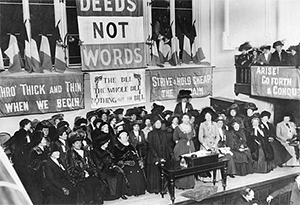
The organization was adamant that its members would be women only and that they would steer clear of operating within the sphere of any one particular political party. The WSPU adopted the colors of purple, white, and green and sold a variety of products sporting the organization's logo and official colors. The WSPU started its own newspaper, Votes for Women and its own press, Woman's Press, which was kept busy printing leaflets and pamphlets containing arguments in favor of women's suffrage. The organization had an official anthem, "The Women's Marseillaise," sung to the tune of "La Marseillaise," the French national anthem; the new anthem later became "The March of the Women."
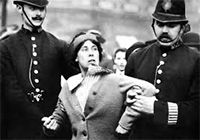
Frustrated with the slow pace of change, the Pankhursts changed their tactics. As the group grew in membership, the group's actions grew in boldness. They took to conducting large demonstrations in front of Parliament; one of these demonstrations led to several arrests of protesters. They also took to committing acts of civilian violence: cutting telephone lines, setting fire to unoccupied houses, sending letter bombs, chaining themselves to railway lines, and destroying greenhouses at Kew Gardens. More and more arrests followed, and women in prison adopted the hunger strike as a method of continuing their protest while behind bars. Prison authorities responded by force-feeding women on hunger strike, and this whole set of events garnered great sympathy for the women who suffered through such things.
One woman who suffered such indignities was Lady Constance Lytton, a member of high society who wanted to vote. She disguised herself as a poor woman and then got herself arrested speaking out for suffrage and endured the hardship of suffragettes in prison. She went on a hunger strike and was finally released. She then told her story, saying that several times while she was in prison, the guards had told her that if she were rich or otherwise had connections, she could leave anytime she liked.
The newspaper The Daily Mail in 1906 had derided the members of the WSPU as "suffragettes." The organization's members, rather than be offended, embraced the term as their own.
Twin sets of actions in 1913 brought the women's suffrage into sharp focus:
- The first was the Cat and Mouse Act, a bill passed by Parliament that aimed to avoid force feeding by allowing prison authorities to release prisoners who were in very poor health because of malnutrition. The name of the bill came from the idea that women would be released and then rearrested because they would return to the kind of activity that got them arrested in the first place.
 The second was the high-profile death of a suffragette. Emily Davison had been arrested nine teams, gone on hunger strike seven times, and been force fed 49 times by 1913. That wasn't what killed her. At the Derby that year, she ran out onto the track during the race and tried to drape a suffrage banner over Anmer, the horse of King George V. Her sudden appearance on the track spooked the horse, the jockey was unable to control the horse, and it trampled Davison. She was severely injured, spent a few nights at a hospital, and died there.
The second was the high-profile death of a suffragette. Emily Davison had been arrested nine teams, gone on hunger strike seven times, and been force fed 49 times by 1913. That wasn't what killed her. At the Derby that year, she ran out onto the track during the race and tried to drape a suffrage banner over Anmer, the horse of King George V. Her sudden appearance on the track spooked the horse, the jockey was unable to control the horse, and it trampled Davison. She was severely injured, spent a few nights at a hospital, and died there.
As did the rival organization the NUWSS, the WSPU suspended its campaigning for suffrage during World War I and supported the home front activities. The newspaper became 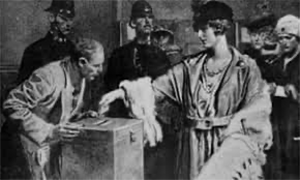 Brittania, and the WSPU became patriotic in its outlook while also reminding the male politicians of the time that if women could do jobs done previously only by men, then women could certainly handle a thing like voting.
Brittania, and the WSPU became patriotic in its outlook while also reminding the male politicians of the time that if women could do jobs done previously only by men, then women could certainly handle a thing like voting.
The WSPU had friends in high places. The longtime Liberal MP George Lansbury was campaigning for women's suffrage as early as 1906. He supported the WSPU's motto of "Deeds, Not Words" and went on hunger strike himself, after getting arrested at a WSPU rally. (He was released after four days.) Another WSPU supporter was David Lloyd George, the first Liberal Prime Minister, in 1916. He oversaw the implementation of the bill that created women's suffrage.
Emmeline Pankhurst
Emmeline Pankhurst was the matriarch of a family whose overriding passion was gaining for women the right to vote. She was born in Manchester in 1858 to politically active parents. An avid reader from an early age, she enjoyed hearing her mother, Sophia Goulden, read Uncle Tom's Cabin to her as a bedtime story. An older Emmeline pronounced as one of her favorite books Thomas Carlyle's The French Revolution: A History.
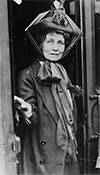
She joined the suffrage cause as a teenager, joining the Women's Franchise League and, more fundamentally, founding the Women's Social and Political Union (WSPU) in 1903. Emmeline and her husband, Richard, had five children, three of whom joined the suffrage cause. Christabel, the oldest daughter, was at her mother's side through the turbulent years and actions that the WSPU adopted, such as storming a session of Parliament and demanding to be heard and advocating civilian violence such as arson. Such actions divided the family, and Emmeline's younger daughters, Adela and Sylvia, withdrew from their mother's orbit.
She was arrested several times for protesting and acts of civil disobedience, including a protest march in 1910 that became known as Black Friday because of the aggressive police response to the protest. She sanctioned hunger striking as a way to advance the cause but was horrified when prison authorities resorting to force feeding women on strike.

She sold her home in 1907 and adopted a life of traveling and speaking, not only in the United Kingdom but also in Canada and the United States, in which she gave a speech in 1913 titled "Freedom or Death." In 1914, she wrote her autobiography, My Own Story.
Emmeline had her fondest wish granted with the Representation of the People Act in 1918. Even though that bill granted suffrage to women only over 30, it was a major victory. She kept on fighting for suffrage for other women, forming the Women's Party and eventually joining the Conservative Party and being selected as a parliamentary candidate for Whitechapel and St. Georges. She died in June 1928, just weeks before the passage of the Representation of the People Act 1928, which granted the vote to women over 21.
Christabel Pankhurst
Christabel was born in 1880 in Manchester. She attended Manchester High School for Girls and earned a law degree from the University of Manchester. She is most well-known for co-founding the Women's Social and Political Union (WSPU), along with her mother, Emmeline.

Christabel joined her mother in advocating civil disobedience and other more militant action in order to advance the cause of women's suffrage. She was arrested several times and became known as the "Queen of the Mob." She lived in Paris for a time and returned to England during World War I and edited the WSPU newspaper The Suffragette, in the pages of which she continued to advocate for suffrage. As did her mother, she embraced the cause of patriotism during the war and helped on the home front, organizing hospital care.
She was overjoyed at the passage of the Representation of the People Act in 1918, which granted women over 30 the right to vote. She ran for Parliament in that year's election, representing the Women's Party; she lost to a Labour Party candidate.
In 1921, Christabel moved to the U.S., where she stayed for the rest of her life, other than a brief return to the U.K. in the 1930. She died in Santa Monica, Calif., in 1958.
Sylvia Pankhurst
Sylvia Pankhurst was born in Manchester in 1882 to Richard and Emmeline Pankhurst, who became well-known in the women's suffrage movement. Sylvia studied at the Manchester School of Art and the Royal College of Art.
She joined her mother and her older sister Christabel in actions taken by the Women's Social and Political Union. She designed the group's logo and many of the banners, leaflets, and posters that  the group used. She wanted women to gain the vote and contributed to the WSPU newspaper Votes for Women. She was arrested several times, went on hunger strike in prison, and was force fed. At the same time, she wanted to expand the WSPU's mission to include the labor movement and other such causes. This eventually caused a rift in the family, and her mother and sister ejected her from the WSPU. She responded by founding her own group, the Women's Suffrage Federation, which became the Workers' Socialist Federation, which made headlines by campaigning against U.K. involvement in World War I. During the war, she attended the International Women's Peace Congress in the Netherlands. She embraced the ideas of Communism and attended international meetings in the Netherlands and the Soviet Union.
the group used. She wanted women to gain the vote and contributed to the WSPU newspaper Votes for Women. She was arrested several times, went on hunger strike in prison, and was force fed. At the same time, she wanted to expand the WSPU's mission to include the labor movement and other such causes. This eventually caused a rift in the family, and her mother and sister ejected her from the WSPU. She responded by founding her own group, the Women's Suffrage Federation, which became the Workers' Socialist Federation, which made headlines by campaigning against U.K. involvement in World War I. During the war, she attended the International Women's Peace Congress in the Netherlands. She embraced the ideas of Communism and attended international meetings in the Netherlands and the Soviet Union.
Sylvia spoke out against the rise of fascism and embraced Ethiopia as a special cause, raising funds for that country's first teaching hospital and using her art expertise to write the book Ethiopia: A Cultural History. She became a friend of Ethiopian Emperor Haile Selassie and lived in that country at his invitation from 1956. She founded the monthly journal Ethiopia Observer
. She died there in 1960.